#ram's horn squids
Explore tagged Tumblr posts
Text

Elements of Zoölogy: A Text-book. Written by Sanborn Tenney. 1875.
Internet Archive
#marine life#mollusks#cephalopods#octopuses#argonauts#ram's horn squids#common octopuses#neon flying squids
425 notes
·
View notes
Text

the squit
#rams horn squid#my art#marine biology#squid#splatoon#(lol)#marine animals#digital art#artists on tumblr
365 notes
·
View notes
Note
Hi!! :D Can I request a rams horn squid please? I think they're really funky. Also!! Thank you so much for running this blog, I have a special interest in cephalopods and I've found it rare to see someone with the same specific interest as me :) I'm really glad you're doing this

Daily Cephalopod #163
#spirulida#rams horn squid#spirula spirula#squid mail くコ:彡#GOOBERS!!!#daily cephalopod#cephalopod#marine life#ocean creatures#ocean critters#marine biology#zoology#animals#biology#cephalopods#marine animals
234 notes
·
View notes
Text






Enjoy these sea critters :)
70 notes
·
View notes
Text

Ah, the sweet rams horn squid. What absolute silly gooses. They have the body of a breakfast sausage.
Like a couple other cephalopods, they are off on their own in the cephalopod family tree. There's nothing else alive QUITE like them.
They have an internal shell that helps them with buoyancy. It looks like this:

Image credit: beachcombingmagazine.com
For a long time we only had trawling samples and their shells to know them by. Then in 2020 we got a video of them! Looking... so suspicious. You'd think we just caught them eating a cookie that their mom very specifically told them were for the COMPANY and not to TOUCH.
Here's the full observation 🦑
128 notes
·
View notes
Text
Taxonomy Tournament: Cephalopods
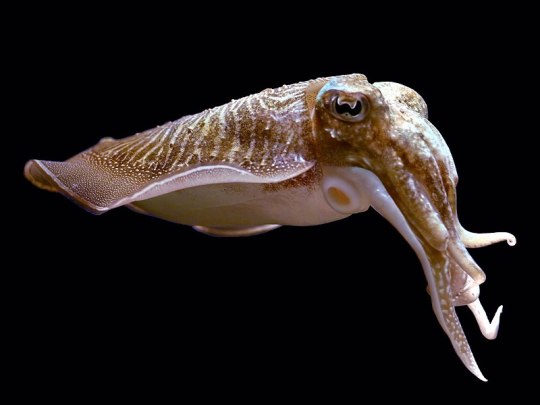
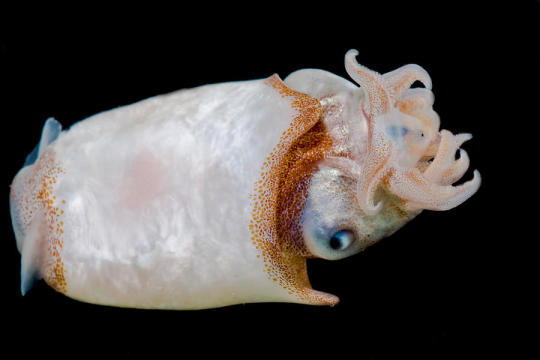
Sepiida. This order is made up of cuttlefish, which have an internal shell called the cuttlebone that is used to control buoyancy.
Spirulida. This order contains only the Ram's Horn Squid, so-called due to the shape of its internal shell, which it uses for buoyancy.
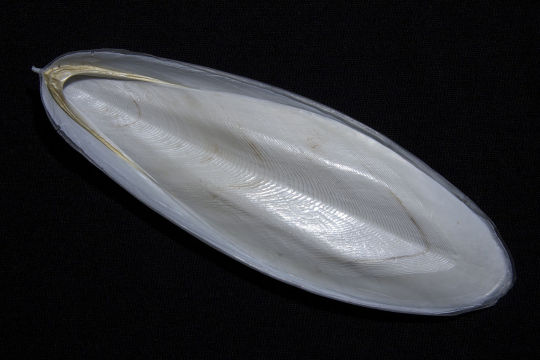
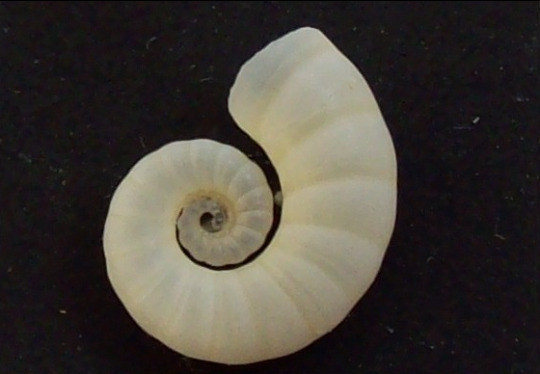
#animals#biology#polls#poll tournament#zoology#cuttlefish#molluscs#cephalopods#spiralia#squid#ram's horn squid#Sepiida#Spirulida#0x29v0xd6#animal tournament#Animal Tournament Round 1
49 notes
·
View notes
Text


Strange spiral remains belonging to the Ram's Horn Squid.
12/09/23 - Spirula spirula
QLD:CQC, Woppa (Great Keppel Island), ocean shore
#invertebrates#invertblr#Spirula spirula#Ram's Horn Squid#Mollusca#squids#Molluscs#mollusks#Decapodiformes#Cephalopoda#Cephalopods#shells
26 notes
·
View notes
Text

》 "Pan-pan" is an urgent signal used in aeronautical and maritime radio communications to indicate a potential emergency in the near future. It comes from the French word panne, which means "failure" or "breakdown". "Pan-pan" is used when there is a possibility of danger, such as low fuel, a fire, or other emergencies that have not yet occurred but could in the near future.
Another Splatoon OC!! Not a player character this time though. Panpan! A 21 year old med student and a frequent Salmon Runner, decently respected at Grizzco.
Even if she's slightly stupid, she's a fantastic medic.
#oh crap art#art#artists on tumblr#oc#Splatoon OC#Panpan#She would have round ears without the headphones unlike most inklings#bc she is a ram's horn squid specifically (thumbs up)#and I personally rlly like the theory that the ear shape is dependant on what the animal's shape is from the side#yes I used the AI overview description of the term but it is still like . accurate to what it means . its like . correct
8 notes
·
View notes
Text
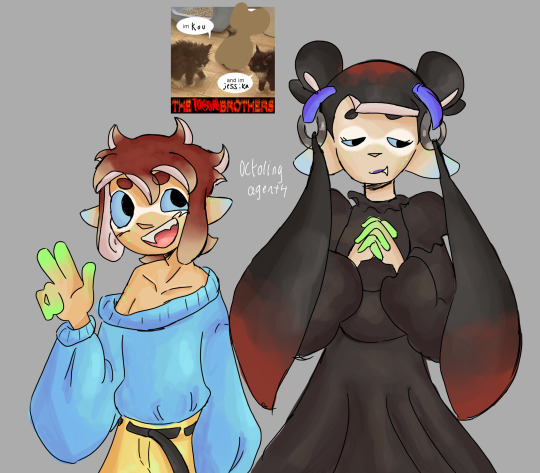
i can't believe nintendo made a sister for my oc isn't that crazy
#lucifer art post :3#splatoon#splatoon 3#yoko horns and friends#yoko and the gold bazookas#jessika toguro#jessika splatoon#explanation: i have an oc named kou toguro and he's a ram's horn squid and then jessika's japanese name is toguro which is#from the ram's horn squid so they're siblings to me now
18 notes
·
View notes
Text
honestly if you wanted to stretch the lore a little bit you could say that the "nautilus" shells in Minecraft are actually an internal shell that the extant squid mob possesses, akin to real-life "squid" from the Spirula genus (aka Ram's Horn Squid). I mean, they're even kind of shaped like it, due to the limitations of the artstyle and the fact that they were such an early mob (i.e. less-detailed); the real things are even bioluminescent, like glow squid. However if this were true one would expect them to actually. You know. Drop their shells. At least on occasion.
#not paleo#minecraft#and of course the ''rams horn'' of the irl squid doesnt really match a nautilus shell besides the spiral design + chambers#but minecraft squid dont exactly match any irl species either. so#artistic licence ig#i did say it was a stretch.
2 notes
·
View notes
Text

Rams horn squid
1 note
·
View note
Text

I love this caption in the Wikipedia entry for the ram's horn squid, Spirula, calling this illustration "dated" because the light is pointing up. They do not mean that the light is on the wrong part of the body, the anatomy here is still reasonable. They just mean these squids always swim with their tentacles pointing up and their lights pointing down.

There you go, wiki editor, I fixed it. And now YOU'RE the one upside-down!! Haha!!! NOW WHO'S DATED!!!!
550 notes
·
View notes
Text
Round 2 - Mollusca - Cephalopoda


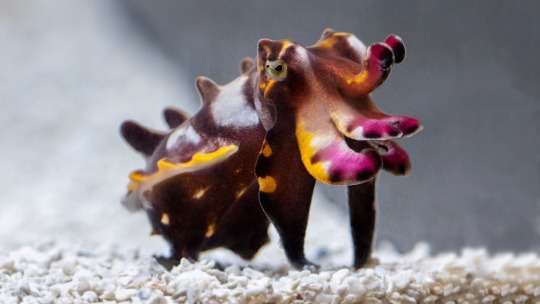

(Sources - 1, 2, 3, 4)
The class Cephalopoda includes the orders Nautilida (Nautiluses), Vampyromorphida (Vampire Squid), Octopoda (Octopuses), Myopsida (Coastal Squids), Oegopsida (Neritic Squids), Bathyteuthida (Bathyteuthid Squids), Idiosepida (Pygmy Squids), Sepiolida (Bobtail Squids), Spirulida (Ram's Horn Squid), and Sepiida (Cuttlefish).
Cephalopods are exclusively marine animals characterized by bilateral body symmetry, a prominent head, and a set of arms or tentacles modified from the more primitive molluscan foot. They are split into two subclasses: the more primitive Nautiloids (represented today by the genera Nautilus and Allonautilus), and the Coleoids (everything else.) Nautiloids retain their external molluscan shell, while coleoids either have an internal shell or have lost it secondarily. Cephalopods are widely regarded as the most intelligent invertebrates and have well-developed senses, large brains, and a complex nervous system. Their brain is protected by a cartilaginous cranium. Nautiloids do not have good vision, and likely perceive their world more through a sense of smell. However, even though coleoid eyes lack a cornea and have an everted retina, they have very acute vision, akin to that of sharks. They can detect polarized light, but most cephalopods are color blind. Despite their color blindness, coleoids are known as masters of disguise, changing color, shape, and texture in milliseconds, and also using colors, patterns, and flashing to communicate with each other! They do this through nervous control of their chromatophores, as well as cells such as iridophores and leucophores reflecting light from the environment. Some squids can even send one message via color patterns to a squid on their right, while they send another message to a squid on their left, splitting their color pattern lengthwise down their body. They may do this by sensing light levels directly through their skin, rather than their eyes, utilizing photosensitive molecules called opsins. They may also be able to utilize chromatic aberration through their oddly shaped pupils.
Cephalopods exchange gases with seawater by forcing water through their internal gills. Water enters the mantle cavity on the outside of the gills, and the entrance of the mantle cavity closes. When the mantle contracts, water is forced through the gills, which lie between the mantle cavity and the funnel. The water's expulsion through the funnel can be used to power jet propulsion. Most cephalopods move via jet propulsion, though this is a very energy-consuming way of travel. Squids, due to their shape and stiff mantles, are able to travel long distances, while octopuses tend to travel slowly along the seafloor relying more on their arms to pull them from place to place. Aside from nautiloids and some octopuses, all known cephalopods have an ink sac, which can be used to expel a cloud of dark ink to confuse predators. The inksac is an extension of the hindgut, opening into the anus, from which the ink can be squirted into the path of the animal’s funnel, allowing the ink to eject further with jet propulsion. This ink is almost pure melanin, which is mixed with mucus upon expulsion, resulting in visual (and possibly chemosensory) impairment of the predator, like a smokescreen. Some cephalopods even release a cloud with greater mucus content so that the ink takes the shape of the cephalopod, while the real one jets away!
Cephalopods hunt via grabbing food with their arms or tentacles, drawing it in to their two-part beak. Most have a radula within their beak. They have a mixture of toxic digestive juices, some of which are supplied by symbiotic algae, which they eject from their salivary glands onto the captured prey. These juices separate the flesh of their prey from the bone or shell. The salivary gland has a small tooth at its end which can be poked into an organism to digest it from within. Cephalopods can be found in all of Earth’s oceans, at all depths, even found within oceanic trenches, though they are most diverse near the equator.
Cephalopods evolved in the Late Cambrian, with the more primitive nautiloids dominating the Ordovician seas, and the more modern coleoids arising in the Lower Devonian. Many groups of cephalopods have been lost to time and are famous for their fossils, including the Ammonoids and Belemnoids. The living Chambered Nautilus (Nautilus pompilius) is also known from Early Pleistocene fossils.

Propaganda under the cut:
The study of cephalopods is called teuthology.
Though superficially similar, ammonoids were more closely related to living coleoids than they were to the shelled nautiloids!
The smallest living cephalopod is the 10mm (0.3 in) long Thai Pygmy Squid (Idiosepius thailandicus).
The largest living cephalopod, and largest living invertebrate is the 700 kilogram (1,500 lb) Colossal Squid (Mesonychoteuthis hamiltoni).
The Atlantic Brief Squid (Lolliguncula brevis) is the only cephalopod known to tolerate brackish water, venturing into the Chesapeake Bay.
Captive octopuses have been known to climb out of their tanks, maneuver across the floor, enter another aquarium to feed on captive crabs, and then return to their own aquarium before their keepers return.
Captive octopuses have also been known to recognize, respond positively to, and even play with their keepers.
The Firefly Squid (Watasenia scintillans) is one of the only cephalopods known to have color vision.
Some cephalopods are able to fly through the air for distances of up to 50 metres (160 ft)! They can achieve these ranges by jet-propulsion, squirting water from their funnel even while in the air. They then spread their fins and tentacles to form wings and actively control lift force with their body posture. The Japanese Flying Squid (Todarodes pacificus) has been observed spreading its tentacles in a flat fan shape and utilizing a mucus film between the individual tentacles. The Caribbean Reef Squid (Sepioteuthis sepioidea) has been observed spreading its tentacles out in a circle to guide its flight. This behavior is presumably for avoiding predators and/or for saving energy during migrations.
Humboldt Squid (Dosidicus gigas) are large, agile pack hunters, flashing red and white to communicate with each other and coordinate attacks on shoals of fish. They are particularly known for being aggressive towards humans, though this aggression may be well founded, as they are the most popular squids to be hunted for food, with around 10 million killed every year. In circumstances where these animals are not feeding or being hunted, they usually exhibit curious and intelligent behavior.
The Vampire Squid (Vampyroteuthis infernalis) is the only living species in the order Vampyromorphida. Despite its name, it is closer related to octopuses. Living in the deep sea, they are small, 30 cm (1 ft) long, and range from jet black to pale red, have spiked arms connected by a webbing of skin, and have the largest proportional eyes in the animal kingdom at 2.5 cm (1 in) in diameter. It is the only cephalopod able to live its entire life cycle in the minimum zone, at oxygen saturations as low as 3%. They lack ink sacs, instead releasing a sticky cloud of bioluminescent mucus containing orbs of blue light from their arm tips. Despite their scary name, spooky appearance, and dazzling wizard spells, these animals mainly feed on detritus as it floats down to the depths.
The genus Hapalochlaena (Blue-ringed Octopuses) consists of four extremely venomous species of octopus that are found in tide pools and coral reefs in the Pacific and Indian oceans, from Japan to Australia. Despite their small size (12 to 20 cm [5 to 8 in]) they carry enough neurotoxic venom to kill 26 adult humans within minutes. The venom can result in nausea, respiratory arrest, heart failure, severe and sometimes total paralysis, blindness, and can lead to death within minutes if not treated. Death is usually from suffocation due to paralysis of the diaphragm. Despite this, blue-ringed octopuses are relatively docile and will only bite if actively harassed, instead choosing to flee or display their warning colors: bright yellow with blue flashing rings. Very few deaths have been recorded.
#i could write soooo much more but this is already so long it took me two hours to write and idek if anyone even reads them rip#round 2#mollusca#animal polls#cephalopoda
138 notes
·
View notes
Text



Hey uhmm, your boyfriend is looking at pictures of squid again. No he said he doesn't want to stop. Ye- no it's the Ram's Horn squid this time. Yeah, Spirula spirula, the one with the internal coiled shell, he's been staring at it for hours now. Maybe you should come pick him up.
1 note
·
View note
Text
What TMA characters do you think would be as an animal? Here's a few of mine! Only just started S4 BTW so opinions may change. Also some of these I based of what the animal represents or their tendencies.
Jon - Moth vibes, dragon fly, fox, panther
Martin - maybe a fox due to appearances. Possibly Cow. Golden retriever personality S1, ooh or an Ainu maybe an artic wolf? Maybe a bear?
Tim - ferret, racoon, lizard, cool animals
Sasha - Mimic Octopus and blue jay for reasons... But yea maybe something mousey or like an owl especially for s1?
Melanie - Pygmy Goat, ram idk she just kinda guves that vibe. Like look at them and then look at her. Same thing.
Basira - crow/raven aka a corvid bcs she's smart
Daisy - wolf, Black-footed cat, other types of hunters
Elias - snake (obvi), jackal, eagle, owl, agree with the horned owl
Peter Lukas - polar bear agree with that, squid/octopus, Kelpie (not real but oh well)
Mike - birds. Idk which just birds. Preferably blue or white. Maybe the Impundulu or Alpine Chough. A goat/ram bcs thunder. Marten. Snow lepord
Michael - Adax, box jellyfish, sea slug, lilac breasted roller
Helen - butterfly, Livingstone's Cichlids, Orchid mantis
Georgie - fluffy cat! Bat, raven, Moth, black swan
Gerry - axolotl, bearded dragon, bat, again cool animals
Trevor - bear, wolf, hawk
Julia - hare, black ram, wolf
Nikola - coyote, cuttlefish, Angler Fish, vampire squid and yknow what screaching owl
Breekon & Hope - margay, rams, bulls, parrot, gorrila, tiger
Danny (Stoker) - honey badger
Any other ideas? Even if it's just one or two give it a whirl ❤️
#the magnus archives#tma#jonathan sims#elias bouchard#jon sims#The magnus crew as animals#martin blackwood#tim stoker#space#not sasha#melanie king#georgie barker#daisy tonner#basira hussain#peter lukas#mike crew#michael crew#michael#tma michael#michael distortion#Helen#helen distortion#gerry keay#tma gerry#gerard keay#nikola orsinov#Nikola#breekon and hope#trevor herbert#julia montauk
50 notes
·
View notes
Text
HEY I JUST HAD AN IDEA!
since I cannot find the motivation or drive to DRAW my ref sheet, I can just describe them in minute detail!
SO Hypnos. this will be split into 4 ish parts because there are 4 major states to them!
Pre life, they are a ghostly sheep with pure white wool but black fur (the short hair beneath the wool, around the face and arms.). They have two short horns, the left one broken halfway up, and Their eyes are pure white. They wear the fleece of the crusader, and have the classic bell, with light brown pants that are held up with a cord belt. they are not affected by gravity, and cannot touch anything (exept in ONE specific circumstance.). they are unaffected by the red moon.
After being forced into a body, they look much the same color-wise, except that now their wool is perpetually dirty. Their left horn remains broken. Their eyes now have pupils, but are mismatched due to the right one being replaced with Leshies eye. that eye also has no eyelid, as Shamura didn't bother. (a worms eye doesn't need an eyelid because it has a protective membrane, but Hypnos now needs to rub at their eye sometimes.) Their ears are now blue, in tatters, and constantly wet due to belonging to a certain squid (the ears can no longer wriggle to express emotion, and it hurts when they feel happy.). They do not speak in their own voice, due to having Hekets throat, but they undergo voice training to try to sound like themselves again. they still croak sometimes. The biggest change, however, is their head shape. No longer shaped like a wedge, like it once was, it is now rounded, with skin having been clumsily removed from their face so that it matched the new curvature. Having Shamuras skull means that they now have a vestigial nose, as spiders do not have one, as well as divots behind their eyes where extra eyes could fit. they also have fangs. They wear the red crown, but its eye does not open, and forms no weapons for them as it tries to maintain their body. they are constantly on the verge of falling apart, Held together by purple thread in messy stiches. their stability (and stitches) greatly improve after Kalamar's care. They wear a heavy iron collar sealed with a golden diamond shaped lock, only open-able by the god of war. their cloak is a tattered, worn version they wore while incorporeal. It is infused with the same magic that binds Hypnos to the world of the living, pulling fervor out of the air and giving the lamb a means to fight. Their magic, shaped by their torment, comes in the form of lightning.
After their rebirth through the cream crown, their stitched together wounds finally heal, though the relics remain embedded in their flesh. The purple thread is gone, leaving only scars. Their wool seems cleaner, and their eyes shine brighter. They no longer wear the red crown, and instead wear the cream crown: a crown with a sideways cream colored eye (and i do mean sideways, even the pupil), the crown itself the shape of a miter hat (a bishops hat, the one that followers use at refineries). Their ruined cloak has transformed into a beautiful wool one that resembles a sunset or perhaps a sunrise on a clear day, retaining some of the powers of its previous form but now works a little differently (if they stand still and 'take a rest', their fervor charges really fast). The shackle on their neck has loosened, not quite free yet, and the lock was warped by the surge of power from an awakening god into a softer shape, resembling a cloud now.
After they have achieved redemption, they have grown into a full god. The relics are truly part of them now, and they have accepted this body as their own. Leshies eye has grown an eyelid made of moss, Kalamars ears now properly wiggle, Hekets voice is full of power, and now flowers sprout from the wool on Hypnos's head. They are much taller now, and their intact horn has grown into a rams horn, while their broken horn has spiraled upward, still broken halfway up. They now wear a cloak embroidered with the patterns of the old faith, but it is dyed to resemble the sun on the horison, with stars still twinkling above. Their wool is now lightly cream tinted at the edges, looking like a soft cloud.
They no longer wear the lock.
#cotl#i really don't know what i'm doing#cult of the lamb#cotl au#sins of the gods au#cotl lamb#cotl oc
16 notes
·
View notes